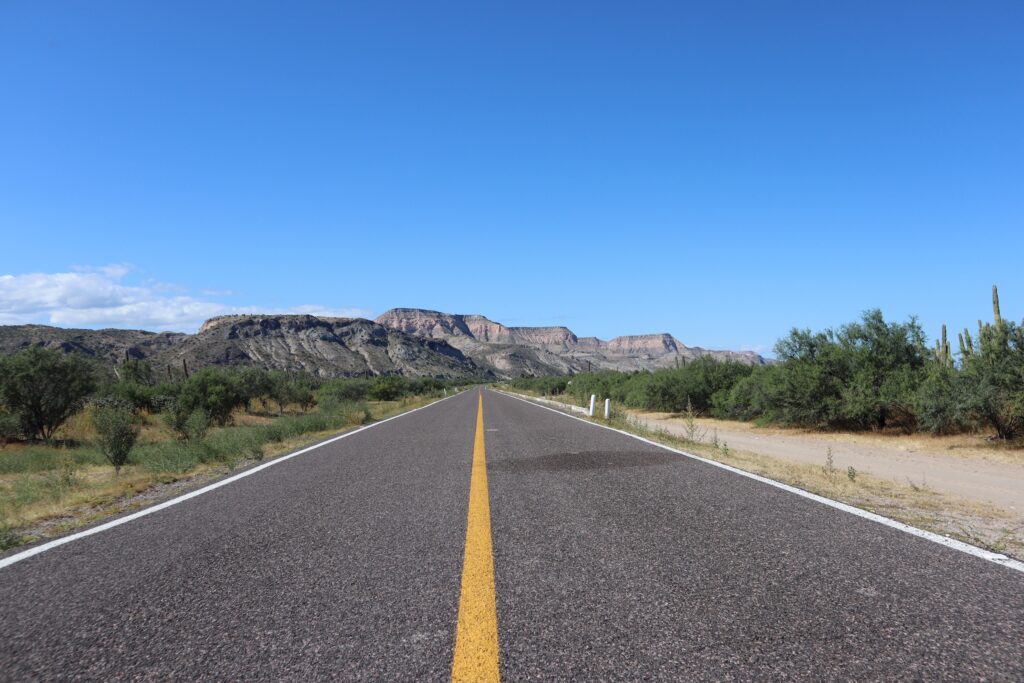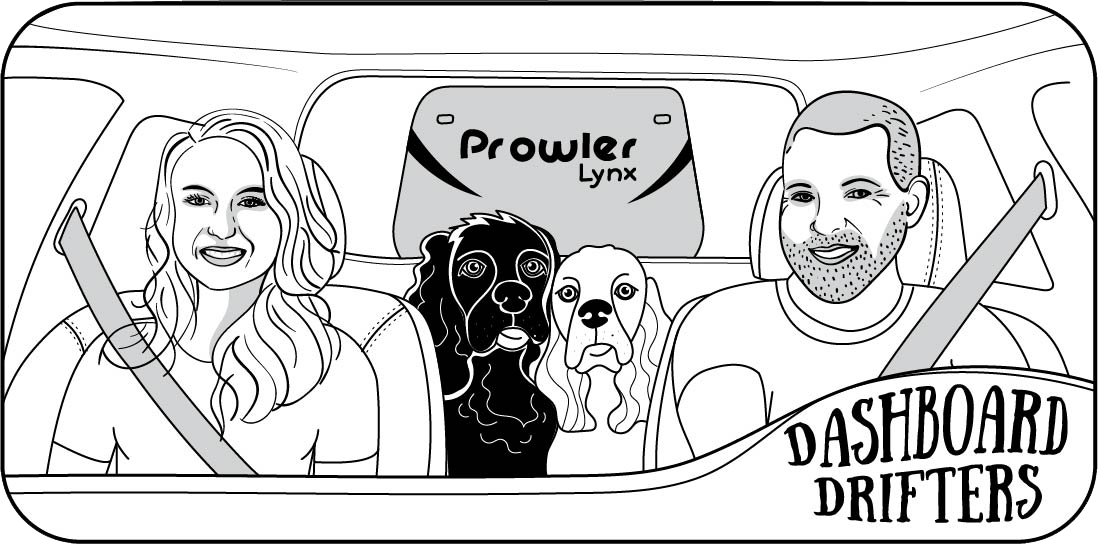8 Tips for Driving in Mexico: Advice from Locals
We just spent ten days touring around Baja California, Mexico. The scenery is breathtaking, the food is delicious, and the people are friendly. Getting around though… well, driving in Mexico is another story.
Here are 8 tips for driving in Mexico, with advice from locals, so you don’t break up with your partner or get too much grey hair.

Check out our galley of photos from this trip!
1. Pre-Plan Your Route
This may seem like an obvious tip, but it needs to be reiterated. Before we left for Mexico, we downloaded maps of the areas we were going to be in so we would have them offline. We opted not to incur roaming charges through our cell phone carrier and knew we would not have data for GPS.
Pre-planning our route included entering in the location or address of where we were going. Then before (keyword: before) we left, we reviewed the directions, and highway numbers.
Mexico roads are numbered just like they are at home and have signs that are easy to understand with the destination and arrows. However, you don’t want to have to jump across three lanes of high-speed traffic to get to your exit on the freeway. Or suddenly come up to your unmarked gravel road turn and have to slam on your brakes.
We do not recommend relying solely on that friendly GPS voice (if you have it). Know where you are going and how to get there. Bonus if you have a competent co-pilot – see tip número dos.
2. Have a Co-Pilot
This may or may not be an option for you but having someone to help you navigate in the passenger seat is a blessing (or a curse). Along with pre-planning your route, we had someone sit shotgun and keep an eye on the map. So instead of having the GPS voice calmly guide our route, my husband had me pointing directions. (Unfortunately for him, instead of saying “left” or “right”, I choose to vaguely point).
The pointing is optional. But having someone else keep an eye out on the signs and map helps a lot. Two sets of eyes are better than one.
3. Drive During the Day
You may have seen this tip in other blogs saying that it is safer to drive during the day in Mexico to avoid unwanted stops from suspicious people (cough* cartel). We are here to tell you that you want to drive in the day so you can see the road.
One thing we noticed right away is that there is little to no shoulder, there are massive potholes, and in some areas the road has disappeared off into a sink hole. Also, there are not a lot of guard rails and so there are sharp drop offs into the abyss.
We were repeatedly told by locals and ex-pats to drive only in the day. They kept saying that we did not want to have to pull over in the dark and fix a flat tire. After seeing the steep cliff and no shoulder, we certainly agreed.
Advice from a local: Only drive during the day so you can see the entire road and any potholes or missing sections.
4. Road “Rules” Are Guidelines
Some similarities to driving in Mexico to Canada and the US: familiar traffic signs, traffic lights (green, amber, and red), and you drive on the right side of the road. The differences driving in Mexico? Those reassuring traffic signs are more of “guidelines” than anything else.
Stop (Alto) signs are at most intersections, however most people coast through after checking both ways. In the instance where more than one vehicle comes up to intersection, it becomes a standoff to who goes first. Typically, the bravest person goes first and everyone else drives defensively.
Turn lights are also optional. (To be fair, a lot of people in Canada and the US also think turn blinkers are optional). Once we got used to the lack of signaling, it was okay. People are not aggressive when driving in Mexico and do not swerve into your lane when there is not enough room.
There are posted speed limits. Typically, we saw signs for 30 km/h, 60 km/h, and 90 km/h (highways). For those from the US, the speed limits are in kilometers and not miles, so make sure you double check your speed.
Again, speed limits are guidelines. Most of the time we went 10-30 km/h more than what was posted. We went a little bit slower than the locals who in some cases were going way, way more than the posted limit.
Advice from a local: Follow what the other drivers are doing. Keep up with the flow of traffic. If no one else is stopping at the stop sign, don’t stop and obstruct traffic.
5. Drive Defensively
If you take only one piece of advice from this blog, it should be this: drive defensively. Pay attention to other cars and do not assume they will follow the “rules”. Maintain extra distance between cars if you can because there are always sudden stops or slowdowns, people changing lanes, animals or people walking near the shoulders, or bikes and ATVs.
6. Be Aware of Potholes, Speed Bumps, and Missing Roads
We have previously mentioned the road conditions and it warrants its own tip. For the most part, the roads in Baja California are well maintained. We were actually surprised that most of the time they were in better condition than the roads back home! Keep your eye out for the unruly pothole though!
However, they have a love of speed bumps. These are not your run of the mill small speed bumps like back home. These are launch pads if you don’t slow down. The speed bumps are painted bright yellow and they have warning signs before you get to them. But seriously, slow down.
Another interesting traffic method they use are these little bumps – like rumble strips. Also called: sleeper lines, growlers, and woo woo strips. In some cases, the placement of these bumps made sense; for example, along the side of the highway, in the lanes, before a cross walk. However, sometimes they are just in the middle of the road.
Finally, there are some areas with broken roads. Along coastal roads there are spots where the road has fallen away. This means that in order to avoid destroying your tires and possibly flipping your car, you have to move into the next lane. Most of the time, if a chunk of road is missing there are pylons. But not always – so refer to tip 3 and drive during the day.
7. How to Deal With the Police
We were warned that we may be pulled over by the federales or polÍcia. Because we are driving a rental car, sometimes the police may target you for traffic violations, real or fake. Police in Mexico only make $4,500 MXN a month ($315 CAD or $240 USD). Because of their low income, they sometimes pull people over and write tickets to get some extra income. It is illegal for you to bribe or pay a mordida to an officer.
Sometimes the police may choose to randomly enforce the laws, for example, stopping at a stop sign. You may stop at the sign and get pulled over for obstructing traffic; you may coast through and get pulled over for not stopping.
Advice from a local: If you are pulled over for by the police for a traffic violation, you need to gather some information. Mark down where the traffic violation allegedly took place and the time. Ask the officer for his badge number and tell them that you want to go to the station to pay the ticket properly. If the officer persists, get out and take pictures of their vehicle, their license plate, and a picture of the officer. This is all legal.
If you do end up with a ticket, go to the station to pay it and get a receipt so that it is legitimate.
8. Have Enough Money to Pay Tolls
Again, this one seems super obvious but let me tell you a traumatic story that happened to us on our last day.
We were driving back to San José del Cabo because that is where we were flying out of. Our host advised us to take Highway 19 around the west side of Baja instead of the east side. We had driven to La Paz on the east side through Los Barriles and wanted to see the other coast. Highway 19 is a toll road, which we knew.
Anyways, we stop at the booth and get our ticket. We didn’t know how much the toll would be. It is important to note that this is our last day in Baja and we had used all our money. We had some change and a $50 MXN so we thought we would be good.
It’s a beautiful drive and then we get to the toll to pay. The total comes up: $97 MXN or $5.20 USD. Well… we have $59 MXN and $1 USD.
Advice from a local: You can’t mix USD and MXN money at the toll booth.
The toll booth operator was not sympathetic to our problem. We offered to pay with credit card, no Bueno, cash only.
A long line of cars had accumulated, and they were not patient. People started honking which made our anxiety skyrocket. The toll booth operator told us that we would have to ask someone for cash. So, I (Jenn) ran to the van behind us and asked a very nice gentleman for $40 MXN.
Now this guy is scrambling to find change for me, people are honking and yelling, the lineup of cars is growing, I am freaking out because I am standing on the side of the road begging for money.
We got money from the sympathetic man, paid our toll (in a mix of US and MXN because they finally took pity on us), and drove on.
Moral of the story: Keep adequate cash for the tolls if you do not want to end up like us.
…
Driving in Mexico is a learning curve. There are a lot of things to pay attention to and it can be a lot when you are also trying to take in the scenic beauty. Driving in Mexico is something I would absolutely recommend though. The freedom of having your own vehicle to go wherever is so liberating. Take your time and let yourself get use to driving though. After all, it’s Mexico and you’ll be using Mexican minutes!
What tips do you have for driving in Mexico?
